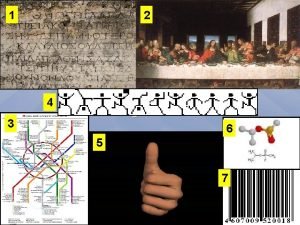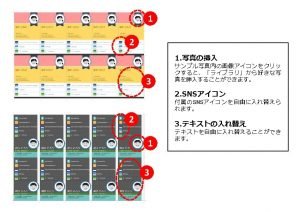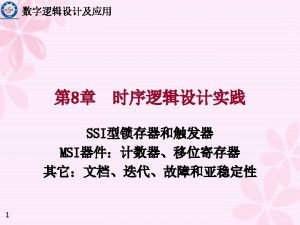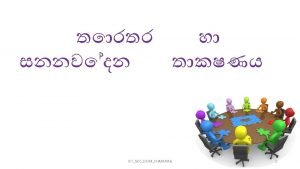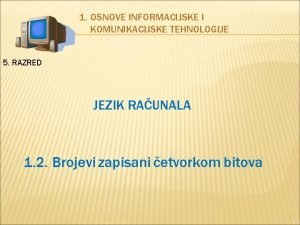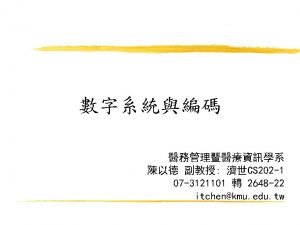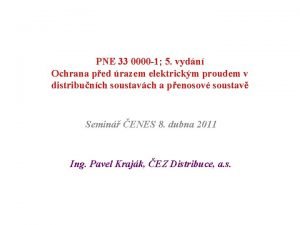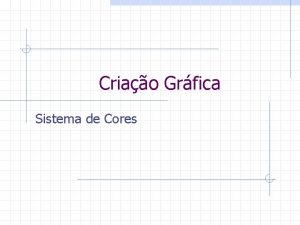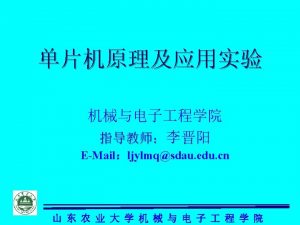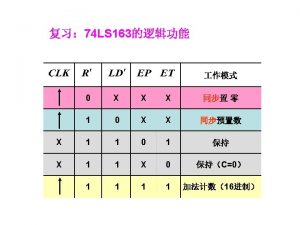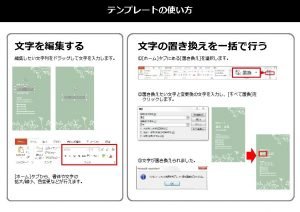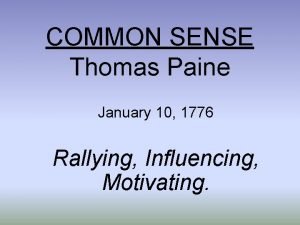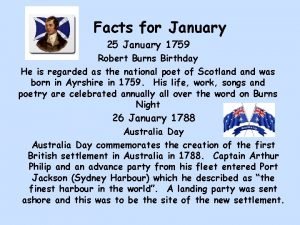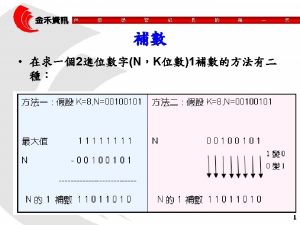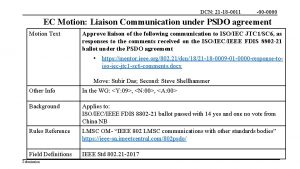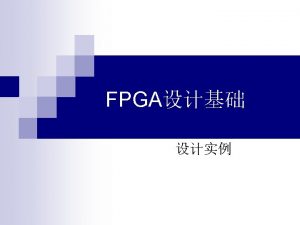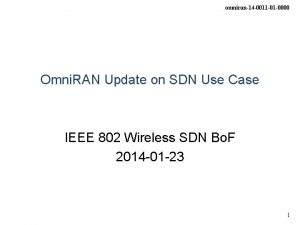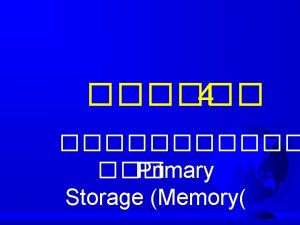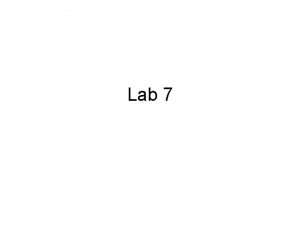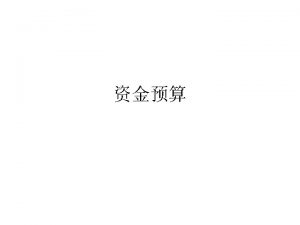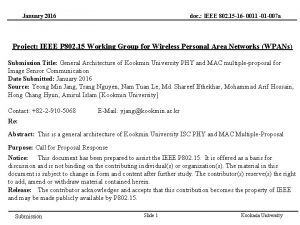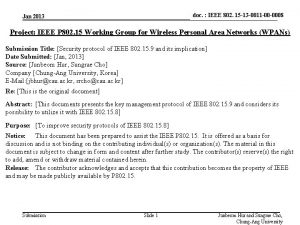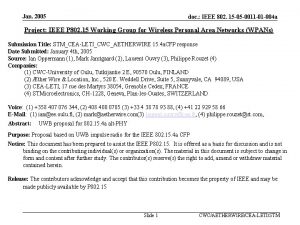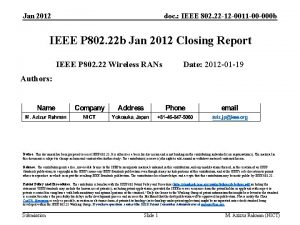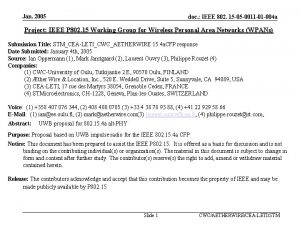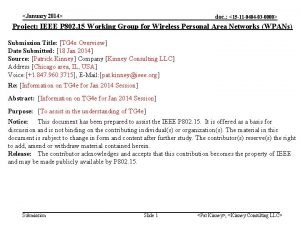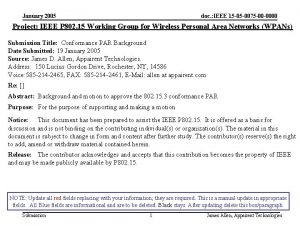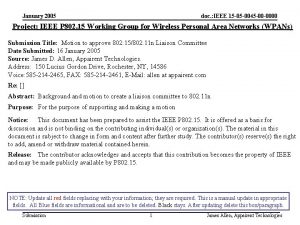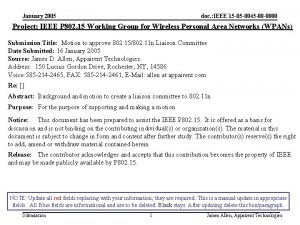doc 11 10 0011 0000 ad January 2010






















![doc. : 11 -10 -0011 -0000 ad January 2010 References [1] Ultra Broad Band doc. : 11 -10 -0011 -0000 ad January 2010 References [1] Ultra Broad Band](https://slidetodoc.com/presentation_image_h2/82dd4647b898d41c7c057fabed03b03f/image-23.jpg)



- Slides: 26

doc. : 11 -10 -0011 -0000 ad January 2010 Radio over Fiber for an optimal 60 GHz Home Area Network Date: 2010 -01 -07 Authors / Contacts: Submission Slide 1 J. Guillory, S. Meyer & B. Charbonnier, Orange Labs

doc. : 11 -10 -0011 -0000 ad January 2010 Contents • Radio over Fiber in the Home Area Network • An example of optical architecture: multipoint-to-multipoint • Setup and results • Using the radio MAC layer for driving the optical infrastructure Submission J. Guillory, Slide. S. 2 Meyer & B. Charbonnier, Orange Labs

January 2010 doc. : 11 -10 -0011 -0000 ad Radio over Fiber in the Home Area Network • The number of connected devices in the home increases , • The rates necessary between each of them increase too. • The ultimate goal in home network, and for a provider of telecommunications like Orange, is to satisfy the demand made by this new services like remote backup, video conference, video on demand, voice over IP, data exchange in high-definition … Submission J. Guillory, Slide. S. 3 Meyer & B. Charbonnier, Orange Labs

doc. : 11 -10 -0011 -0000 ad January 2010 Radio over Fiber in the Home Area Network • We need high rates in the whole home because the devices and our home gateway are not necessary in the same room. ace p s rk o W Computer and NAS Parent’s bedroom Children’s bedroom Kitchen Submission Television and Games console Living-room Laptop and Phone Garage Home Gateway J. Guillory, Slide. S. 4 Meyer & B. Charbonnier, Orange Labs

January 2010 doc. : 11 -10 -0011 -0000 ad Radio over Fiber in the Home Area Network • The wireless connectivity is generally preferred for the final link to the device (easy to use and very flexible). • In the future, IEEE 802. 11. ad will be the radio standard to transport data at very high throughputs (above 1 Gbps), • But, this radio standard has a short range (less than 10 m). How can we enlarge the coverage of the radio signal ? Submission J. Guillory, Slide. S. 5 Meyer & B. Charbonnier, Orange Labs

doc. : 11 -10 -0011 -0000 ad January 2010 Radio over Fiber in the Home Area Network ace p s rk o Children’s bedroom Parent’s bedroom W Kitchen Living-room Garage Remote antenna : converted electrical signal (radio) to optical signal, and vice-versa Two optical fibers (downlink and uplink). We transport radio signals in their native format (analogue) on an optical carrier Submission Slide 6 J. Guillory, S. Meyer & B. Charbonnier, Orange Labs

doc. : 11 -10 -0011 -0000 ad January 2010 Radio over Fiber in the Home Area Network • So, the Radio over Fiber system enlarges the coverage of the radio signal itself. It consists in transporting the radio signal from wireless devices onto an optical carrier for distribution over optical fibre to different remote antennas. The optical link acts as an analogue repeater. • Transporting the radio signals in their native format, provides the advantage of remote antenna simplification and transparency to radio layer protocols. Optical In Photodiode DC TX A antenna DC Block Bias Tee TEE Laser Optical Out A RX antenna Direct modulation is simple and low cost. The remote antenna has small size, light weight and low power consumption. RF Filter Automatic Gain Control Submission Slide 7 J. Guillory, S. Meyer & B. Charbonnier, Orange Labs

January 2010 doc. : 11 -10 -0011 -0000 ad Radio over Fiber in the Home Area Network • Why optical fibers ? • Only the fiber optic can enlarge the coverage of radio signal transparently. • It offers a very high bandwidth and low attenuation, thus can transfer the high rate of the radio over several hundred meters. • It will be a natural extension of access networks (Fiber To The Home). • It is the ideal candidate to provide long life-span local networks. Submission J. Guillory, Slide. S. 8 Meyer & B. Charbonnier, Orange Labs

January 2010 doc. : 11 -10 -0011 -0000 ad Radio over Fiber in the Home Area Network • Besides, the Radio over Fiber optimizes the global spectral efficiency. • Indeed, power is radiated only in the spot (room) where it is useful. • We have a full control of the range of radio wave (no trouble of the radio signals of neighbours, health and hacking concerns). Submission J. Guillory, Slide. S. 9 Meyer & B. Charbonnier, Orange Labs

doc. : 11 -10 -0011 -0000 ad January 2010 Contents • Radio over Fiber in the Home Area Network • An example of optical architecture: multipoint-to-multipoint • Setup and results • Using the MAC layer for driving the optical infrastructure Submission J. Guillory, Slide S. 10 Meyer & B. Charbonnier, Orange Labs

doc. : 11 -10 -0011 -0000 ad January 2010 An example of optical architecture: multipoint-to-multipoint ce or W a ksp Two optical fibers Parent’s bedroom Children’s bedroom Living-room Kitchen Power is radiated only in the spot where it is useful (Space) and when it is necessary (Moment). Garage Gateway + ONT Nx. N Splitter Fiber To The Home Submission J. Guillory, Slide S. 11 Meyer & B. Charbonnier, Orange Labs

doc. : 11 -10 -0011 -0000 ad January 2010 An example of optical architecture: multipoint-to-multipoint Remote antenna without intelligence Ro. F 1 Ro. F 2 Is equivalent to Ro. F 3 Ro. F 4 Nx. N Gateway Splitter + ONT Wireless device with radio chipset Submission J. Guillory, Slide S. 12 Meyer & B. Charbonnier, Orange Labs

doc. : 11 -10 -0011 -0000 ad January 2010 An example of optical architecture: multipoint-to-multipoint • Main advantages / disadvantages : • Self-sufficient system: the distribution of resources managed by the radio MAC layer. • No intelligence required: direct communication possible. • Optical budget should allow the Nx. N optical splitter (16 x 16 = 12 d. B). • Two optical fibers required per remote antenna. Submission J. Guillory, Slide S. 13 Meyer & B. Charbonnier, Orange Labs

doc. : 11 -10 -0011 -0000 ad January 2010 Contents • The Radio over Fiber in the Home Area Network • An example of optical architecture: multipoint-to-multipoint • Setup and results • Using the radio MAC layer for driving the optical infrastructure Submission J. Guillory, Slide S. 14 Meyer & B. Charbonnier, Orange Labs

doc. : 11 -10 -0011 -0000 ad January 2010 Setup and results ace p s rk o Living-room Kitchen Children’s bedroom Parent’s bedroom W Garage Gateway + ONT Splitter Optical splitter ( 8 x 8 = 9 d. B ) It behaves as an optical tunnel Submission J. Guillory, Slide S. 15 Meyer & B. Charbonnier, Orange Labs

doc. : 11 -10 -0011 -0000 ad January 2010 Setup and results What is the necessary Signal to Noise Ratio to have when a device receive the radio signal ? OFDM QPSK : 2 Gbps and BER of 10 -11 → 6. 5 d. B. OFDM 16 QAM : 2 Gbps and BER of 10 -11 → 13 d. B. SCBT : no data about the required SNR. (ECMA 387 / 57 -66 GHz radio standard) SNR at radio receiver versus distance on the first and second hop in free space (Optical loss = 11 d. B) Simulation at f = 66 GHz Submission J. Guillory, Slide S. 16 Meyer & B. Charbonnier, Orange Labs

doc. : 11 -10 -0011 -0000 ad January 2010 Contents • The Radio over Fiber in the Home Area Network • An example of optical architecture: multipoint-to-multipoint • Setup and results • Using the radio MAC layer for driving the optical infrastructure Submission J. Guillory, Slide S. 17 Meyer & B. Charbonnier, Orange Labs

doc. : 11 -10 -0011 -0000 ad January 2010 Using the radio MAC layer for driving the optical infrastructure • The lasers that are turned-on without seeing radio data at the input, are noise for the photodiodes that receive an optical signal from another laser (copy of the ambient noise by adding the noise of the conversions). • Interferences : beat between independent light sources. ace p s rk o W No ise Parent’s bedroom MAC monitoring Signal Noise Living-room Kitchen Signal Children’s bedroom Laser ON Garage Gateway + ONT Splitter Noise Submission J. Guillory, Slide S. 18 Meyer & B. Charbonnier, Orange Labs

doc. : 11 -10 -0011 -0000 ad January 2010 Using the radio MAC layer for driving the optical infrastructure • Bridge : MAC Monitoring signal. • Only one of the device (e. g. the gateway) demodulates the radio signal, • Recovers useful data in the radio MAC layer to manage the optical access (turning-on laser or photodiode), • Sends instruction to remote antenna by a monitoring signal. Submission J. Guillory, Slide S. 19 Meyer & B. Charbonnier, Orange Labs

doc. : 11 -10 -0011 -0000 ad January 2010 Conclusion • We have shown the feasibility of a wireless network inside the home with Radio over Fiber for extending the radio coverage. • Then, the Radio over Fiber optimizes the global spectral efficiency. • The optical architectures show good results, and need information from radio MAC Layer to be managed. Submission J. Guillory, Slide S. 20 Meyer & B. Charbonnier, Orange Labs

doc. : 11 -10 -0011 -0000 ad January 2010 Questions to the group • What do you think about the concept of Radio over Fiber ? • Do you think it is an interesting concept ? • Do you think it is in the scope of 802. 11 ad standard ? • Some comments ? Submission Slide 21 J. Guillory, S. Meyer & B. Charbonnier, Orange Labs

doc. : 11 -10 -0011 -0000 ad January 2010 Thank you Submission J. Guillory, Slide S. 22 Meyer & B. Charbonnier, Orange Labs
![doc 11 10 0011 0000 ad January 2010 References 1 Ultra Broad Band doc. : 11 -10 -0011 -0000 ad January 2010 References [1] Ultra Broad Band](https://slidetodoc.com/presentation_image_h2/82dd4647b898d41c7c057fabed03b03f/image-23.jpg)
doc. : 11 -10 -0011 -0000 ad January 2010 References [1] Ultra Broad Band Wireless Home Network based on 60 GHz WPANs cells interconnected via Ro. F M. Huchard, M. Weiss, A. Pizzinat, S. Meyer, P. Guignard, B. Charbonnier Invited paper IEEE Journal of Lightwave Technology [2] Ultra Wide Band over fibre transparent architecture for high bit-rate home networks A. Pizzinat, F. Payoux, B. Charbonnier, S. Meyer Springer Annals of telecommunication Journal (Special Issue on Home Networking) [3] RNRT/BILBAO project: first results on Ultra Wide Band over fiber S. Paquelet, S. Mallegol, G. Froc, A. Bisiaux, A. Pizzinat, B. Charbonnier, N. Malhouroux, S. Meyer, F. Payoux, I. Siaud, G. Salingue, D. Morche, H. Jacquinot, S. Bories, C. Algani, AL. Billabert, S. Mazer, JL. Polleux, C. Rumelhard, M. Terré, C. Sillans, Y. Le Guennec, B. Cabon, M. Lourdiane, G. Maury International UWB Workshop 2007, Grenoble, France. [4] Ultra Wide Band Home Networks by Means of a Low Cost Radio-over-Multi. Mode-Fibre Transparent System A. Pizzinat, I. Louriki, B. Charbonnier, S. Meyer, C. Sillans, H. Jaquinot, S. Bories, M. Terré, C. Algani, AL. Billabert, Y. Le Guennec, P. Lombard, G. Froc Network and Optical Communications 2008, Krems (Austria), 1 -3 July 2008 [5] Optical fiber infrastructures for UWB access and FTTH B. Cabon, Y. Le Guennec, P. Lombard, M. Lourdiane, JM. Duchamp, A. Pizzinat, I. Louriki, B. Charbonnier, F. Payoux, S. Meyer, M. Terré, C. Algani, AL. Billabert, C. Sillans, H. Jaquinot, S. bories, G. Froc ISIS workshop, Stokholm, June 2008 [6] Low Cost Transparent Radio-over-Fibre System for UWB Based Home Network A. Pizzinat, I. Louriki, B. Charbonnier, F. Payoux, S. Meyer, M. Terré, C. Algani, AL. Billabert, C. Sillans, H. Jaquinot, S. Bories, Y. Le Guennec, G. Froc European Conference on Optical Communications 2008, Bruxelles 21 -25 Sept. 2008 Submission J. Guillory, Slide S. 23 Meyer & B. Charbonnier, Orange Labs

doc. : 11 -10 -0011 -0000 ad January 2010 Appendix Submission Slide 24 J. Guillory, S. Meyer & B. Charbonnier, Orange Labs

doc. : 11 -10 -0011 -0000 ad January 2010 An experimental setup and the results LNA HLNAV-386 G = 18 d. B NF = 5. 5 d. B 3 X Mini-Circuit ZX 60 -14012 L-S+ Gunit = 12 d. B P 1 d. B = 8 d. Bm Vers NFunit = 6 d. B détecteur HBM 15 X-208 Insertion loss = 8. 5 d. B CAG 2 CAG 1 X LNA HPA HPA /2 HBUC 15 X-073 Insertion loss = 9 d. B Ro. F P = -6. 5 d. Bm -60. 6 <P< -10. 7 d. Bm -42. 6 <P< 7. 8 d. Bm -51. 1 <P< -0. 7 d. Bm HGV 54. 5551515 -I 57 < FRF < 66 GHz -45. 1 <P< -23. 7 d. Bm P = -39. 5 d. Bm P = -3. 5 d. Bm Optical loss = ~9 d. B X P = -5. 25 d. Bm HHPAV-331 G = 20 d. B P 1 d. B = 15 d. Bm NF = 8 HPA P = -14. 25 d. Bm P = 5. 75 d. Bm HGV 54. 5571815 -I 57 < FRF < 66 GHz 3 < FFI < 12 GHz Ro. F link with FINISAR laser and photodiode (TOSA HFE 6 X 92 -X 61 and ROSA HFD 6 X 80 -418) : GRo. F = 1. 25 d. B / NF = 49 d. B / Gopt = -2. 5 d. B Submission Slide 25 J. Guillory, S. Meyer & B. Charbonnier, Orange Labs

doc. : 11 -10 -0011 -0000 ad January 2010 An experimental setup and the results SNR at RX input for input P 1 d. B = 15 d. Bm 20 18 16 8 x 8 Optical splitter loss SNRmin 2 Gbps OFDM-16 QAM New results SNR, d. B 14 12 SNRmin 2 Gbps OFDM-QPSK 10 New amplifier after the photodiode (G = 12 d. B / NF = 6 d. B) 8 6 4 2 Photodiode in différentiel mode + Balun 10 m + 10 m 5 m + 5 m 10 m + 5 m 5 m + 10 m 0 2 4 6 8 10 Optical loss, d. B 12 14 16 SNR at radio receiver versus optical loss, and distance on the first and second bond in free space. Submission Slide 26 J. Guillory, S. Meyer & B. Charbonnier, Orange Labs
 0001 0010
0001 0010 0,000 0,000 0,000
0,000 0,000 0,000 0011 0111
0011 0111 Binary 0011
Binary 0011 0011 binary to decimal
0011 binary to decimal 0011 znacenje
0011 znacenje Introduction to binary numbers
Introduction to binary numbers 0000 0001 0010
0000 0001 0010 Percentili crescita feto
Percentili crescita feto 952 203-0000
952 203-0000 0000=4 puzzle
0000=4 puzzle Ochrana polohou živých částí
Ochrana polohou živých částí Cor #0000
Cor #0000 Chart for military time
Chart for military time Ljmp
Ljmp Xxx 0000
Xxx 0000 ?3305501049 0000 28|.|091 27|.|071 98|.|553 102|.|311 13`
?3305501049 0000 28|.|091 27|.|071 98|.|553 102|.|311 13` 0000 0001
0000 0001 1 000 000 0000
1 000 000 0000 25 january scotland
25 january scotland Nysedregents
Nysedregents Pro-forma entry
Pro-forma entry January 10th 1776
January 10th 1776 His birth date was on 25 january 1759
His birth date was on 25 january 1759 Character trait respect
Character trait respect Wolfgang amadeus mozart death cause
Wolfgang amadeus mozart death cause February and march season
February and march season
